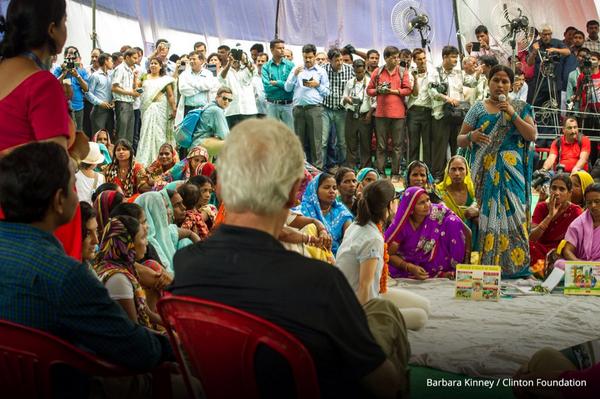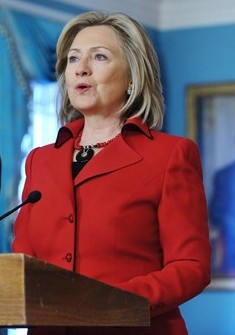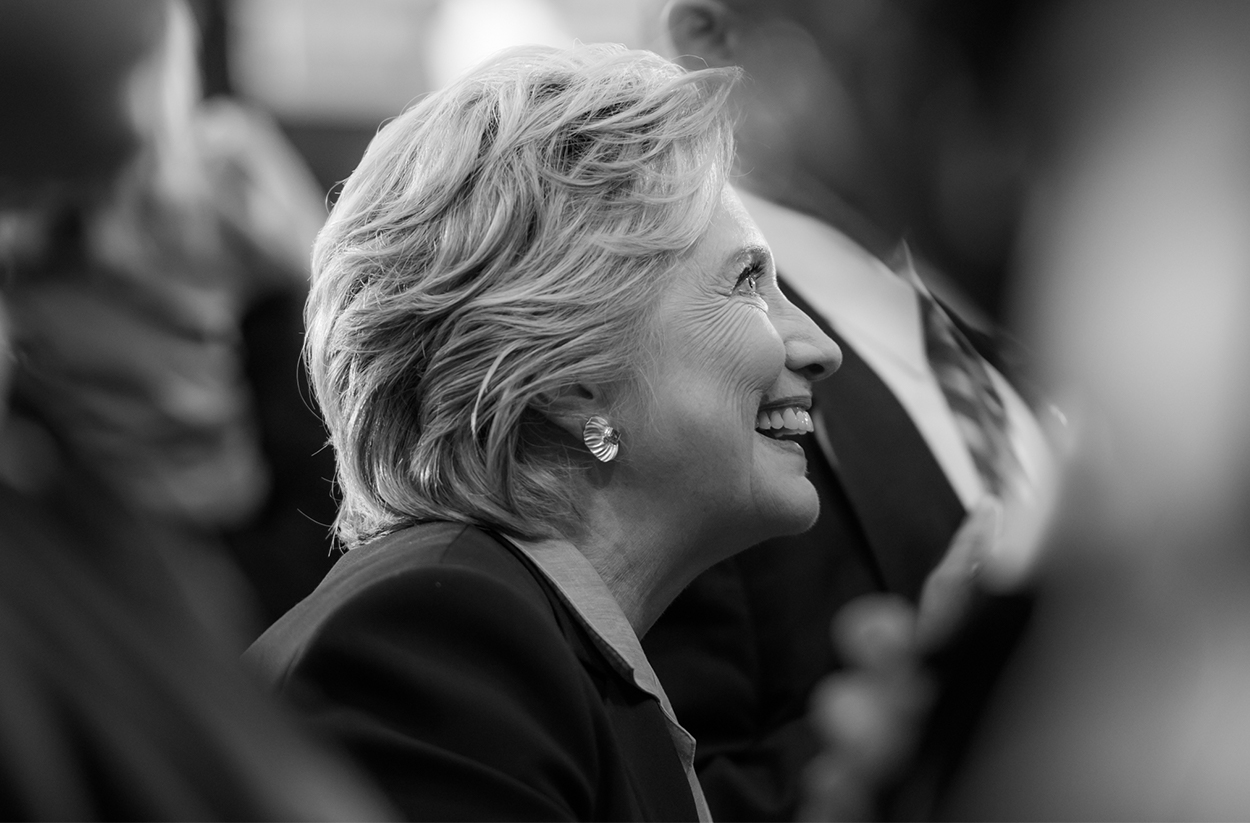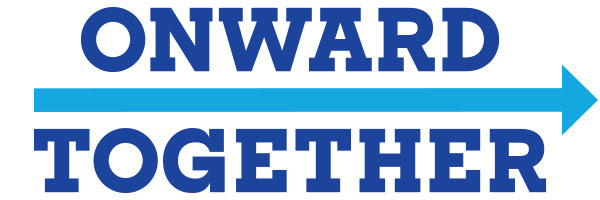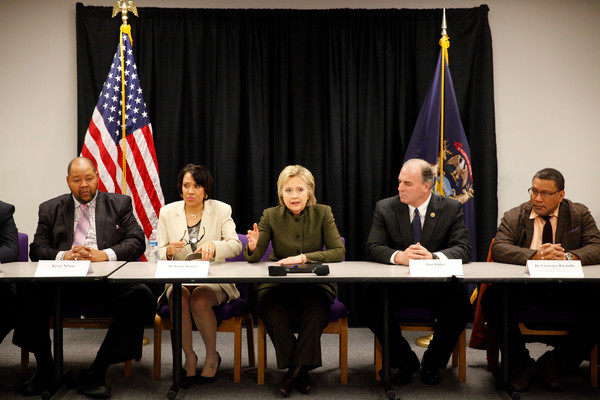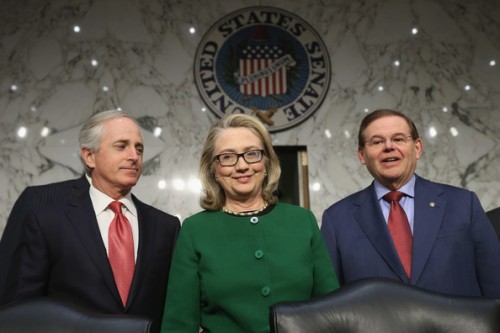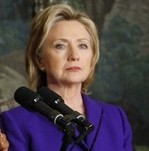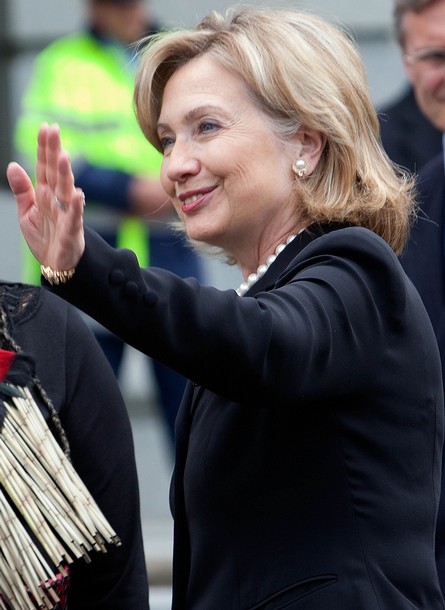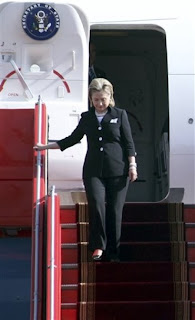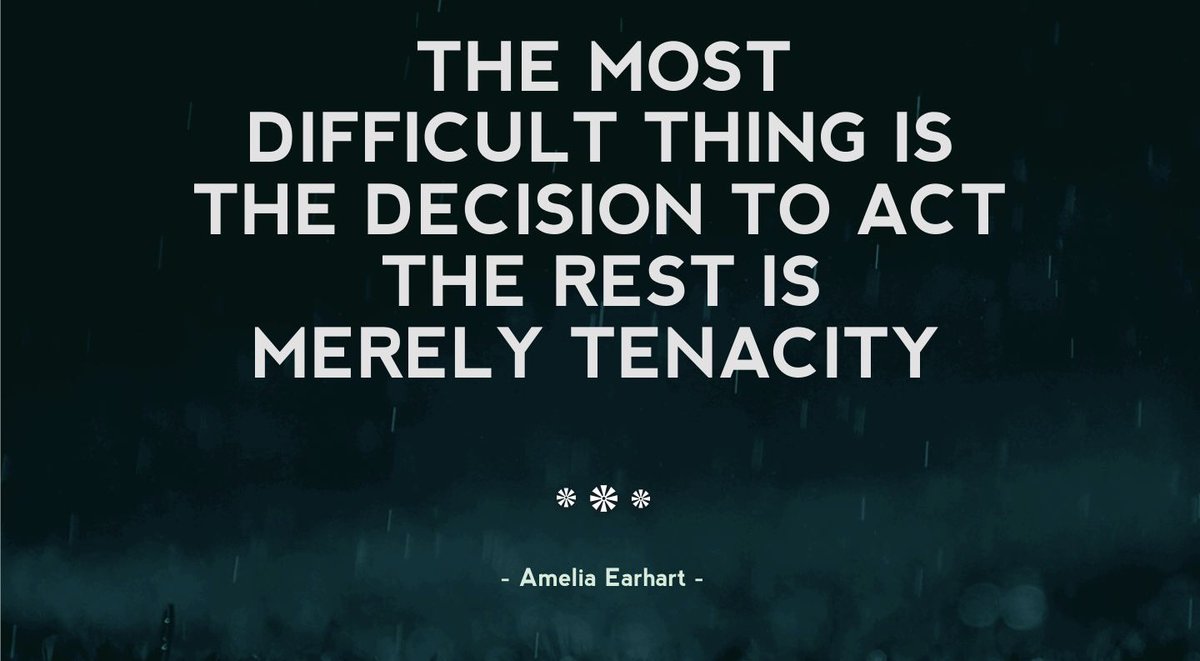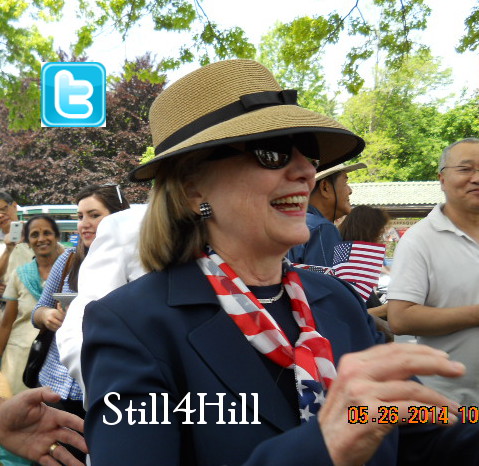DR. MORRISON: Aloha.
AUDIENCE: Aloha.
DR. MORRISON: How do you introduce the Secretary of State? And I think the first thing I think of as a public servant, we sometimes hear the word public servant spoken in a kind of derogatory tone. But the public servants that I’ve known, the members of our state and local government, members of our Congress, members of the international community, with a lot of volunteers and within a certain (inaudible) of the Department of State, are people who are incredibly dedicated and work tirelessly.
But there’s no one, I think, who is more tireless than the Secretary of State, and our own little vignette on this is that there was 25 years that the East-West Center saw no Secretary of State come to our campus. And in the last two years, we’ve seen this Secretary of State three times. (Applause.) Now I have learned one other thing about her this time. She is a risk-taker. We told her that the weather was going to be raining, the program should be on the inside, and she told us that the weather was going to be fine – (laughter) – that the program was going to be on the outside. And you can see who won the argument – (laughter) – but I think calculated and intelligent risk and something we also need in public service.
So I’m very pleased to present our Secretary of State Hillary Rodham Clinton. (Applause.)
SECRETARY CLINTON: Thank you. Thank you all. Aloha.
AUDIENCE: Aloha.
SECRETARY CLINTON: And it is such a great pleasure for me to be here, back in Hawaii and at the East-West Center. This is America’s gateway to Asia, and one of the loveliest places in the world. I cannot speak for the 25 years of gap between secretaries of state coming here, but I am pleased that I have found my way here now for the third time. And the United States is so proud to host this year’s APEC Leaders’ Meeting in Honolulu, not only because we are committed to our partners in APEC, but also because it gives us the chance to share with them Hawaii’s beauty and culture, and I know that President Obama is eager to welcome everyone to his hometown when he arrives here tomorrow.
Now, there are so many people in this audience that I would like to acknowledge. First, we are joined by leaders and representatives from a dozen Pacific Island nations. This region is known as the Asia Pacific, but sometimes the second word gets less attention than the first. And the Obama Administration has taken many steps to right that balance. We have reopened our USAID office, reinvigorated our commitment to the Pacific Island Forum, and have worked more closely with all our Pacific partners to address urgent challenges from climate change to pandemic health threats to environmental degradation. So I want to thank the Pacific Island leaders for joining us today, and for their continuing partnership with the United States. And if I could, I would like all the leaders to stand so that we can properly recognize them. (Applause.)
And of course, there are other very important representatives of Hawaii and our country here with us today. My dear friend and a great leader for our country, Senator Daniel Inouye, and his wonderful wife Irene. Thank you, Senator, Irene. (Laughter.) Representative Colleen Hanabusa and Representative Mazie Hirono, thank you both for being here. (Applause.) Governor, thank you for being here and welcoming me with a warm Aloha. (Applause.) The governor said he was much happier to see me in Hawaii than in Washington. I wonder why. (Laughter.) I also have a number of other friends who are here, in particular former Governor and Mrs. Ariyoshi who are here, thank you – (applause) – former Governor and Mrs. Waihee who are here, thank you – (applause) – and so many others whom I am always pleased to see and look forward to continuing our relationship on a range of issues.
I know that it’s exciting for all of us to be here on the cusp of APEC, and I want to thank Charles Morrison and everyone at the East-West Center because, as you heard from Charles, this is the third time I’ve come on my way to somewhere else in the Asia Pacific, and I’m always grateful for the opportunity to come here to the East-West Center, because the ties between East and West are absolutely critical to our U.S. foreign policy. And to that end, I know that this is a whole-of-government effort. It’s not only our civilian representatives who are focused on and engaged with the Asia Pacific, but also our military leaders, and I want to thank Admiral Willard, Admiral Walsh, and all of the military leaders who represent us so well in the Asia Pacific. Thank you very much. (Applause.)
Now from the very beginning, the Obama Administration embraced the importance of the Asia Pacific region. So many global trends point to Asia. It’s home to nearly half the world’s population, it boasts several of the largest and fastest-growing economies and some of the world’s busiest ports and shipping lanes, and it also presents consequential challenges such as military buildups, concerns about the proliferation of nuclear weapons, natural disasters, and the world’s worst levels of greenhouse gas emissions. It is becoming increasingly clear that in the 21st century, the world’s strategic and economic center of gravity will be the Asia Pacific, from the Indian subcontinent to the western shores of the Americas. And one of the most important tasks of American statecraft over the next decades will be to lock in a substantially increased investment – diplomatic, economic, strategic, and otherwise – in this region.
Across the United States Government, under President Obama’s leadership, our diplomats, military leaders, and trade and development experts are hard at work reinforcing our relationships in the region to set us on a course for broad and lasting progress.
Events elsewhere in the world have also lined up in a way that helps makes this possible. The war in Iraq is winding down. We have begun a transition in Afghanistan. After a decade in which we invested immense resources in these two theaters, we have reached a pivot point. We now can redirect some of those investments to opportunities and obligations elsewhere. And Asia stands out as a region where opportunities abound.
We have a model for what we and our partners in the region are working to achieve. It is what the United States and our partners in Europe achieved together in the past 50 years. The 20th century saw the creation of a comprehensive transatlantic network of institutions and relationships. Its goals were to strengthen democracy, increase prosperity, and defend our collective security. And it has paid remarkable dividends, in Europe itself, in our thriving two-way trade and our investment, and in places like Libya and Afghanistan. It has also proven to be absolutely critical in dealing with countries like Iran. The transatlantic system is and always will be a central pillar of America’s engagement with the world.
But today, there is a need for a more dynamic and durable transpacific system, a more mature security and economic architecture that will promote security, prosperity, and universal values, resolve differences among nations, foster trust and accountability, and encourage effective cooperation on the scale that today’s challenges demand.
And just as the United States played a central role in shaping that architecture across the Atlantic – to ensure that it worked, for us and for everyone else – we are now doing the same across the Pacific. The 21st century will be America’s Pacific century, a period of unprecedented outreach and partnership in this dynamic, complex, and consequential region.
Now this goal is not ours alone. It is one that many across the region hold. I have heard from many different counterparts across the Asia Pacific an urgent desire for American leadership, which has brought benefits to this region already for decades. The United States is proud of our long history as a Pacific nation and a resident diplomatic, military, and economic power. And we are here to stay.
The alliances we’ve built over the years help provide the security that’s made it possible for countries throughout Asia to prosper. American ships patrol sea lanes and keep them safe for trade; American diplomats help settle disputes among nations before they escalate. We’ve been a major trade and investment partner, a source of innovation, a host to generations of students, and a committed development partner, helping to expand opportunity and bring economic and social progress to millions of people. And as a staunch advocate for democracy and human rights, we have urged countries to strengthen their own societies and allow their own citizens to live free and dignified lives.
Just as our engagement has already delivered results for the people of Asia, it has and will continue to deliver results for the American people. This is a point I particularly want to emphasize. At this time of serious economic challenges, I am well aware of the concerns of those in our own country that the United States downsize our work around the world. When they hear me and others talk about a new era of engagement in Asia I know they think to themselves, “Why would we increase our outreach anywhere? Now’s the time to scale back.” This thinking is understandable, but it is mistaken. What will happen in Asia in the years ahead will have an enormous impact on our nation’s future, and we cannot afford to sit on the sidelines and leave it to others to determine our future for us. Instead, we need to engage and seize these new opportunities for trade and investment that will create jobs at home and will fuel our economic recovery.
And there are challenges facing the Asia Pacific right now that demand America’s leadership, from ensuring freedom of navigation in the South China Sea to countering North Korea’s provocations and proliferation activities to promoting balanced and inclusive economic growth. The United States has unique capacities to bring to bear in these efforts and a strong national interest at stake.
Now that’s the why of America’s pivot toward the Asia Pacific. Now, what about the how? What will this next chapter in our engagement with Asia look like? It starts with a sustained commitment to the strategy we have followed in this administration, what I have called forward-deployed diplomacy. That means dispatching the full range of our diplomatic resources, including our highest-ranking officials, our diplomats and development experts, and our permanent assets, to every country and corner of the region.
Specifically, we are moving ahead on six key lines of action, which I have previously discussed in depth. They are: strengthening our bilateral security alliances; deepening our working relationships with emerging powers; engaging with regional multilateral institutions; expanding trade and investment; forging a broad-based military presence; and advancing democracy and human rights.
In the next two weeks, we will make progress on all of these fronts. I will join President Obama as he hosts the APEC Leaders’ Meeting right here in Honolulu, and next week in Indonesia as he becomes the first American president to attend the East Asia Summit. We will also place special emphasis on engaging each of our five treaty allies, starting with the President’s extended meeting with Japanese Prime Minister Noda here in Hawaii. The President will then go on to Australia, and I will travel to the Philippines and Thailand. And later this month, I’ll visit South Korea for the Fourth High-Level Forum on Aid Effectiveness.
So these coming days represent a significant period of engagement, and let me briefly describe our goals, tracking our travels from APEC to our allies to the East Asia Summit. Economic issues are front and center in these relationships. American businesses are eager for more opportunities to trade and invest in Asian markets. And we share with most nations the goal of broad-based, sustainable growth that expands opportunity, protects workers and the environment, respects intellectual property, and fosters innovation.
But to accomplish these goals, we have to create a rules-based order, one that is open, free, transparent, and fair. As a member of APEC and host of this meeting, the United States will drive an agenda focused on strengthening regional economic integration, promoting green growth, and advancing regulatory cooperation and convergence. And we will continue to work through APEC to invest in the economic potential of women, whose talents and contribution still often go untapped. This agenda will create jobs and generate growth for all of us, but only if all of us play by the rules. We have to remove barriers, both at borders and behind borders, barriers like corruption, the theft of intellectual property, government practices that distort fair competition. Economic integration must be a two-way street.
There is new momentum in our trade agenda with the recent passage of the U.S.-Korea Free Trade Agreement and our ongoing work on a binding, high-quality Trans-Pacific Partnership, the so-called TPP. The TPP will bring together economies from across the Pacific, developed and developing alike, into a single 21st century trading community. A rules-based order will also be critical to meeting APEC’s goal of eventually creating a free trade area of the Asia Pacific.
The United States will continue to make the case that, as a region, we must pursue not just more growth but better growth. This is not merely a matter of economics. It goes to the central question of which values we will embrace and defend. Openness, freedom, transparency, and fairness have meaning far beyond the business realm. Just as the United States advocates for them in an economic context, we also advocate for them in political and social contexts.
We support not only open economies but open societies. And as we engage more deeply with nations with whom we disagree on issues like democracy and human rights, we will persist in urging them to reform. For example, we have made it clear to Vietnam that if we are to develop a strategic partnership, as both nations desire, Vietnam must do more to respect and protect its citizens’ rights.
And in Burma, where the United States has consistently advocated for democratic reforms and human rights, we are witnessing the first stirrings of change in decades. Now, many questions remain, including the government’s continued detention of political prisoners, and whether reform will be sustained and extended to include peace and reconciliation in the ethnic minority areas. Should the government pursue genuine and lasting reform for the benefits of its citizens, it will find a partner in the United States.
As for North Korea, it shows a persistent disregard for the rights of its citizens and presents a major security challenge to its neighbors. We will continue to speak out forcefully against the threat from the regime that it poses to its own people and beyond.
Our commitment to democracy and human rights is shared by many nations in the region, in particular our treaty allies – Japan, South Korea, Australia, the Philippines, and Thailand. These five alliances are the fulcrum for our efforts in the Asia Pacific. They have underwritten regional peace and security for more than half a century. They leverage our regional presence and enhance our regional leadership at a time of evolving security challenges.
And now we are updating those alliances for a changing world with three guidelines in mind. First, we are working to ensure that the core objectives of our alliances have the political support of our people. Second, we want our alliances to be nimble and adaptive so they can continue to deliver results. And third, we are making sure that our collective defense capabilities and communications infrastructure are operationally and materially capable of deterring provocation from the full spectrum of state and non-state actors.
All these issues will be addressed in our upcoming visits and meetings. When the President meets with Prime Minister Noda, they will discuss the full breadth of our engagement that makes the U.S.-Japan alliance the cornerstone of peace and security in the region. In Australia, President Obama will celebrate the 60th anniversary of the U.S.-Australia alliance and chart a future course for the partnership. I will do the same in the Philippines, where our two countries will sign the Manila Declaration, which sets forth a shared vision for continued cooperation between our nations. And in Thailand, I will convey our steadfast support for the Thai Government and people as they face the worst floods in their history. In South Korea, we will show once again how our alliance has gone global, through our work together in the G-20 and the Nuclear Security Summit, and now a major forum South Korea is hosting on development aid.
The United States takes very seriously the role that our military plays in protecting the region, including more than 50,000 U.S. servicemen and women stationed in Japan and South Korea. As this region changes, we must change our force posture to ensure that it is geographically distributed, operationally resilient, and politically sustainable. A more broadly distributed military presence provides vital advantages, both in deterring and responding to threats, and in providing support for humanitarian missions.
As we reaffirm and strengthen our Pacific alliances, we are also intensifying our Atlantic alliances, as Europe becomes more engaged with Asia. We welcome that. American and European diplomats have begun regular consultations to align our assessments and approaches. An effective partnership with Europe will be vital to solving many of the challenges facing Asia, and more cooperation between the Pacific and Atlantic regions could help us all in meeting our global problems.
As President Obama and I conclude our upcoming visits to our key treaty allies, I will join him next week at the East Asia Summit in Indonesia. We are proud to be part of the EAS, and we believe it should become the premier forum for dealing with regional political and security issues, from maritime security to nonproliferation to disaster response.
On this last issue in particular, the United States is ready to lend our expertise to help build the capacity of the East Asia Summit and other institutions to respond swiftly and effectively when natural disasters strike. From the 2004 tsunami to the earthquake earlier this year in Christchurch, New Zealand, the earthquake, tsunami, and nuclear disaster in Japan, the flooding now happening in Thailand, the United States stands ready to contribute, to deliver aid, to provide expertise and capabilities, financial resources. Other nations are now making disaster resilience a higher priority. Because even when disaster strikes just one country alone, the impact is widely felt, so this calls out for a closely coordinated regional response.
And that’s what strong regional institutions can help provide, like the East Asia Summit, APEC, ASEAN, and the ASEAN Regional Forum. We need to be able to muster collective action when it is called for, reinforce a system of rules and responsibilities, reward constructive behavior with legitimacy and respect, and hold accountable those who undermine peace, stability, and prosperity. The institutions of the Asia Pacific have become more capable in recent years, and the United States is committed to helping them grow in effectiveness and reach. We are answering the calls to us from the region in playing an active role in helping to set agendas.
Our ability to build a successful regional architecture will turn on our ability to work effectively with the emerging powers, countries like Indonesia, or India, Singapore, New Zealand, Malaysia, Mongolia, Vietnam, Brunei, and the Pacific Island countries. So we’re making a concerted effort to build closer and more extensive partnerships with all these nations. India and Indonesia in particular are two of the most dynamic and significant democratic powers in the world, and the United States is committed to broader, deeper, more purposeful relations with each. And we want to actively support India’s look east policy as it grows into an act east policy.
Our most complex and consequential relationships with an emerging power is, of course, with China. Some in our country see China’s progress as a threat to the United States, while some in China worry that America seeks to constrain China. In fact, we believe a thriving China is good for China, and a thriving China in – is good for America. President Obama and I have made very clear that the United States is fundamentally committed to developing a positive and cooperative relationship with China.
Expanding our areas of common interest is essential. Secretary of the Treasury Tim Geithner and I, along with our Chinese counterparts, launched the Strategic and Economic Dialogue in 2099. These are the most intensive and expansive talks ever conducted between our governments, and we look forward to traveling to Beijing this spring for the fourth round. Now, we are looking to China to intensify dialogue between civilian and military officials through the Strategic Security Dialogue so we can have an open and frank discussions on the most sensitive issues in our relationship, including maritime security and cyber security.
On the economic front, the United States and China have to work together – there is no choice – to ensure strong, sustained, balanced future global growth. U.S. firms want fair opportunities to export to China’s markets and a level playing field for competition. Chinese firms want to buy more high-tech products from us, make more investments in our country, and be accorded the same terms of access that market economies enjoy. We can work together on these objectives, but China needs to take steps to reform. In particular, we are working with China to end unfair discrimination against U.S. and other foreign companies, and we are working to protect innovative technologies, remove competition-distorting preferences. China must allow its currency to appreciate more rapidly and end the measures that disadvantage or pirate foreign intellectual property.
We believe making these changes would provide a stronger foundation for stability and growth, both for China and for everyone else. And we make a similar case when it comes to political reform. Respect for international law and a more open political system would also strengthen China’s foundation, while at the same time increasing the confidence of China’s partners.
We have made very clear our serious concerns about China’s record on human rights. When we see reports of lawyers, artists, and others who are detained or disappeared, the United States speaks up both publicly and privately. We are alarmed by recent incidents in Tibet of young people lighting themselves on fire in desperate acts of protest, as well as the continued house arrest of the Chinese lawyer Chen Guangcheng. We continue to call on China to embrace a different path.
And we remain committed to the One-China policy and the preservation of peace and stability across the Taiwan Strait. We have a strong relationship with Taiwan, an important security and economic partner, and we applaud the progress that we have seen in cross-Strait relations between China and Taiwan during the past three years and we look forward to continued improvement so there can be peaceful resolution of their differences.
To those in Asia who wonder whether the United States is really here to stay, if we can make and keep credible strategic and economic commitments and back them up with action, the answer is: Yes, we can, and yes, we will. First, because we must. Our own long-term security and prosperity depend on it. Second, because making significant investments in strengthening partnerships and institutions help us establish a system and habits of cooperation that, over time, will require less effort to sustain.
That’s what we learned from our transatlantic experiment. It took years of patient, persistent efforts to build an effective regional architecture across the Atlantic. But there is no question it was worth every political dialogue, every economic summit, every joint military exercise. For hundreds of millions of people in Europe, the United States and the transatlantic community has meant more secure and prosperous lives. If we follow that path in Asia, building on all that we have already done together, we can lift lives in even greater numbers. And this region can become an even stronger force for global progress.
In 1963, President Kennedy gave a speech about the Atlantic community in Frankfurt, Germany. Now, that was at a time when many people were convinced that it would not last. President Kennedy described an “Atlantic partnership: a system of cooperation, interdependence, and harmony, whose people can jointly meet their burdens and opportunities throughout the world.” He acknowledged that there would be difficulties, delays, doubts, and discouragement. But the process of partnership would grow stronger as nations and people devoted themselves to common tasks. He said then, “Let it not be said of this Atlantic generation that we left ideals and visions to the past. We have come too far, we have sacrificed too much, to disdain the future now.”
Well, today, on the opposite side of the world, we have faced a similar juncture. This Pacific generation has and will face difficulties. But our region is more secure and prosperous than it has ever been, and that is directly linked to the cooperation that has blossomed among us. The more we have seen each other’s well-being as beneficial to ourselves, the better things have become for all of us.
Our work may have began long ago, but we are called today with new urgency to carry it forward. And in this, the United States is fully committed. We are ready to engage and to lead, on behalf of our citizens, our neighbors and partners, and the future generations whose lives will be shaped by the work we do today together.
Thank you all very much. (Applause.)
DR. MORRISON: I think that speech was breathtaking in its comprehensiveness, and it was also inspirational and it was visionary, and I think all of us here are proud to be part of the team. There’s no place in the world that I think has a greater stake in the future of U.S.-Asia Pacific relations, so we thank you very much for that speech, which, with the two other speeches, makes a very nice trifecta of speeches. Thank you.
And the Secretary, as she did when she stood here before, has agreed to take three student questions, and I think the first student question is ready. It’s Pattama Lenuwat there, and she is a Thai student in our leadership program, so Pattama.
QUESTION: Thank you very much, Madam Secretary, for sharing the foreign policy to Asian – Asia Pacific countries. I feel much appreciate for the policy that the U.S. Government have for the rest of the world, especially for Asian countries. I am Pattama from Bangkok, Thailand, land of smiles, I can say. If you see me smiling, it doesn’t mean that I’m happy all the time, especially during the severe flooding in Bangkok at this moment. And unfortunately, our first female prime minister cannot come to participate APEC meeting this time, so – but I believe that U.S. Government will give a lot of support in terms of financial support to Thailand.
But my question is, in order to see my country to be developed in sustainable way, I would like to know: Is there any plan from the U.S. Government to encourage or increase the trade in Thailand after the flooding is relieved? Thank you.
SECRETARY CLINTON: Well thank you, and our hearts go out to the people of Thailand. This has been a terrible flood and has covered a great portion of Thai countryside, and now, as you said, in Bangkok, it is slow, unfortunately, to recede. So the numbers of people that are without homes may be as high as 2 million, and we are deeply concerned by what is happening right now and what the consequences of this flooding will be. Because your prime minister could not come to APEC – and I think she made exactly the right decision; she must stay and help to lead the efforts to protect the people and take other necessary actions – I will be going to Thailand and I will be bringing with me a strong message of support and solidarity and specific measures of assistance.
We are very willing to help the Thai Government and the Thai people, but we want to be sure that we are responding to the help requested. It is not for us to make a judgment about what you need. It is for us to sit with your government and for your officials to tell us what you require and then for us to respond. But I have been working with Admiral Willard, the leader of our Pacific Forces with the Pentagon. I talked with Secretary of Defense Panetta before I left. So I will be coming with a list of ways we are prepared to help, but also to hear what will be most necessary. And I like the way you said this, that we should look at what we need to do immediately, but then once we get through this terrible period, what more can we do to help Thailand embark on a path of sustainable development.
DR. MORRISON: Now we have Derek Mane. He’s from the Solomon Islands and he’s a Pacific – a South Pacific scholar.
QUESTION: Thank you again, Madam, for the wonderful speech that has been (inaudible) of today. I have a couple of questions, but – however, for the (inaudible) I might be asking just two questions based on the U.S. (inaudible) in the Pacific region. My first question would be on the human right – violence in West Papua. What is the United States stand on the issue of violation of human rights in West Papua in Indonesia?
The other question that I might like, also, to (inaudible) is the economic leverage that China is getting into the region as well. For instance, the Ramu investment in Papua New Guinea for the coal mining, and also the proposed Fiji mining that’s also China involvement in heavy – in economy. What is the view of the United States on that influence? Thank you.
SECRETARY CLINTON: With respect to your first question, we have very directly raised our concerns about the violence and the abuse of human rights. We do not believe there is any basis for that. There needs to be continuing dialogue and political reforms in order to meet the legitimate needs of the Papua people, and we will be raising that again directly and encouraging that kind of approach.
With respect to Chinese investment, the United States does not object to investment from anywhere, particularly in our Pacific Island friends, because we want to see sustainable growth. We want to see opportunities for Pacific Islanders. But as I said in my speech, we want also to see investment carried out by the United States, by China, by anyone, according to certain rules that will truly benefit the countries in which the investment occurs. We also strongly believe that the interests of the countries need to be protected. So that if there is development of natural resources, which we are finding are quite prevalent in the Pacific Island nations, we want the people of those nations to benefit, not just the companies and the countries that do the extraction.
So we want a rules-based, fair, free, transparent, level playing field for investment and doing business. But perhaps even more importantly, we want to see the countries benefit. We don’t want to wake up in a decade and see that natural resources have been depleted, you don’t have any better roads, you don’t have any better schools, you don’t have any better health care, you don’t have jobs for the people of the countries themselves because labor’s been imported. So we want to be sure that everybody is signed up to a system of investment and business that will truly benefit the countries where it occurs. So that’s one of the reasons we are pushing quite hard on a rules-based system, and why we’re also talking with our colleagues in – not only the Pacific Island nations, but elsewhere in the region – about what they can do to try to maintain their natural resource heritage.
A couple of countries have done it very well. A country like Norway, which struck oil, put a very large percentage of the oil revenues into a trust fund for the future benefit of Norwegians. Botswana, which has made a great deal of economic benefit from the diamond industry, created a trust fund, so it’s one of the reasons why Botswana has the best roads, why you can drink the water, why the school system is nationwide. That’s what I want to see. I’m not against anybody investing, my own companies, anybody else’s companies. But I want nations to stand up for their rights and to make sure that the benefits of the investments don’t just go to a few members of the elite but benefit the people of these countries who deserve that kind of economic growth. (Applause.)
DR. MORRISON: Now we have Mian Cui from China.
QUESTION: Good morning, Secretary Clinton.
SECRETARY CLINTON: Good morning.
QUESTION: My name is Mian. I’m from China. Since you talk a lot about making new rules, I would like to ask you a question about the future rule-makers still in school right now.
SECRETARY CLINTON: Yes.
QUESTION: So in this year, President Obama’s speech in the State of Union, he actually said – talked about foreign students studying in the States. He said, like, some are the children of under – undocumented workers, others come here from abroad, study in our colleges and universities, but as soon as they obtain advanced degrees, they send – we send them back home to compete against us.
So I’m actually asking: What kind of adjustment or any changes do U.S. Government want to make or are thinking of making right now in terms of staying ahead in this competition of global talents? And also, what do you expect international education exchange programs to do, and what kind of role do you expect them to play in this process? Thank you.
SECRETARY CLINTON: That’s a great question because it’s something I feel passionately about. And my colleague from the State Department, with whom I work closely on these issues, Assistant Secretary Kurt Campbell and I, really zeroed in on the importance of greater student exchanges. So we’re doing several things. We have a program to try to get 100,000 more students – more American students studying in China, more Chinese students coming to the United States, but we’re also doing that with Indonesia, with Malaysia, with other countries as well. We want to increase the number of students coming to the United States from Japan and South Korea, which historically have been large pools of students now that needs to be reinvigorated.
We also have a very exciting program that will – that President Obama will be announcing to work with the East-West Center to teach more students in the region English, so that they could perhaps pursue educational opportunities in the United States. Senator Inouye has been a staunch supporter of student exchanges, because he knows how important they are. And so we’re going to keep pushing this. And we’re also trying to change our rules and regulations so that students both are – find it easier to come in the first place and easier to stay after they finish their education. So we fully agree with you that we want to put more emphasis on this.
Another area that we’re focused on is opening up more American colleges and universities across the region, because we think that higher education is one of our great exports, and not every Chinese student or Indonesian student will be able to come study in the United States, but if we can have American colleges and universities that run high-quality programs, we’ll be able to reach more students.
So on all of these aspects of this challenge, we are committed and we’re going to do everything we can to increase numbers and to make it easier and to try to restore the level of student exchange that we had prior to 9/11. Because really, it was 9/11 that began to shut down our borders, make security much more difficult, and we lost a lot of students who decided they would go to Australia, or New Zealand, or China, or India, or somewhere else. And so we have worked hard to clear away some of the necessary security issues to get more students. And we want more American students to go and study as well. So hopefully, you’ll begin to see the changes that we’re working toward in the very near future.
Thank you all very much. (Applause.)
Thank you, Charles. Always good to be here with you.
DR. MORRISON: Okay. Thank you. We wish the Secretary well as she does her duties.














 Hillary Clinton
Hillary Clinton